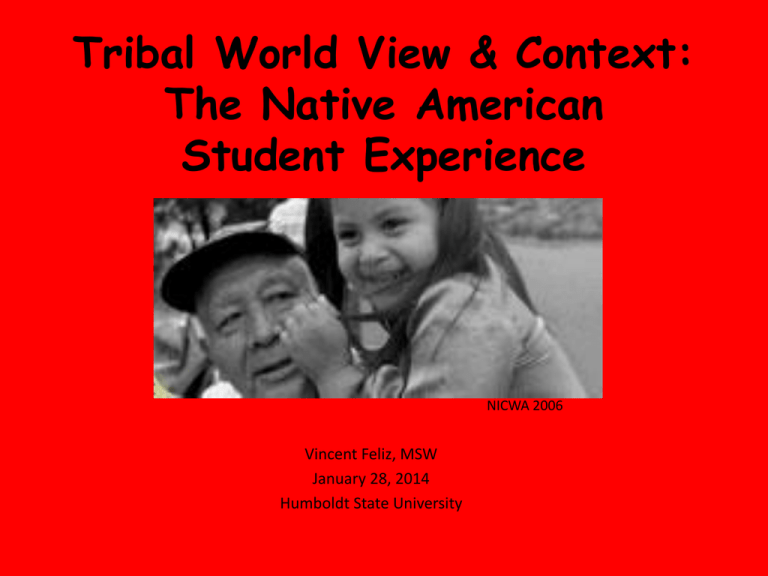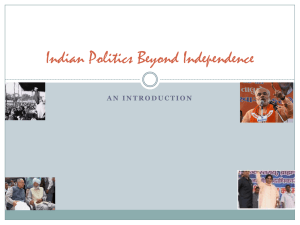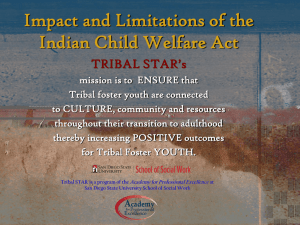PowerPoint slides - Humboldt State University
advertisement

Tribal World View & Context: The Native American Student Experience NICWA 2006 Vincent Feliz, MSW January 28, 2014 Humboldt State University NORMS What is needed for us to feel emotionally safe to share and take healthy risks during this workshop? Who Are We, Etc… Using the sheet of paper provided, please answer the following.. *Name, what is your role/position on campus? *Share where your hometown is located *Discuss your earliest memory of having exposure to American Indian culture Born and raised in Bakersfield, California Youngest of 10 children Since 1993, Active Practitioner of my family’s traditional Chumash Language, Songs, Regalia and Ceremonial Knowledge Since 1998, Drug and Alcohol Treatment Counselor for American Indian Children, Youth and Families. Extensive Work Worth Juvenile Justice System, Community/Continuation Schools. Currently, Student Support & Former Foster Youth Liaison HSU Office of Student Affairs Abundance of Language Pre-contact California was what the field of linguistics refers to as a “language hot spot.” This means that mile for mile there were more Indigenous peoples speaking linguistically diverse and different languages throughout California, then there were in any other part of the United States at that time. • It is estimated that there was a different language being spoken every 20 miles. • A conservative estimate in the number of Indigenous languages being spoken in California pre-contact: 150. • (Indigenous California Languages currently being spoken: ~50.) • Factors in Federal Policies Contributing to Disparity and Mistrust • Policies of genocide with the intent to terminate Native people • Policies that made spiritual gatherings, ceremony and tradition illegal at a time that they were needed most • Forced removal and displacement from homelands • Policies of assimilation such as relocation in the 50’s • Termination of Rancherias which left Tribes without federal recognition and stripped them of land, resources and funding with no ability to support behavioral health services More Federal Policies • “Termination” policy of 1950’s and l960’s ended the government to government relationship with 100 Tribes. The result was disastrous and discontinued Federal support, resulted loss of land held in Trust and loss of tribal identity. • Federal policy of “Relocation” in the l950’s and 1960’s promised jobs, housing, health care and a new life to those moving from rural to urban areas. • Urban population is very diverse. No support was forthcoming, Urban Indian Centers evolved. America’s Indigenous People Exist and Cope HOW DID WE GET TO THIS PROBLEM? “OUR PEOPLE HAVE BEEN DISENFRANCHISED AND THEIR MENTAL ILLNESS ORIGNATES IN THE SYSTEM AROUND THEM, THE ENVIRONMENT, AND THE SURROUNDING HISTORICAL TRAUMA. THEY ARE NOT “CRAZY”THEY ARE PEOPLE RESPONDING TO THE TRAUMA IN THEIR LIFE.” Unhealthy Living & Non-Success The Indian peoples of Northwestern California-Tolowas, Yuroks, Karuks, Wiyots, Hupas, and others-underwent their first massive encounter with EuroAmericans beginning in 1850. Suddenly, in the first few months of that year, news of a gold strike on the Trinity River brought an estimated 10,000 fortune seekers into the Klamath River drainage. That was the beginning of what Indian people came to call, variously, “the end of the world”, “the time when the stars fell”, and “the end of Indian time” (Buckley, 1997) “Like Children of Jewish Holocaust Survivors, Subsequent Generations of American Indians also Have a Pervasive Sense of Pain from What Happened to Their Ancestors.” (BraveHeart & Duburyn, 1984) In terms of success in schooling, American Indian high school students are dropping out at a rate of 50% and even 85% percent in some specific areas. The reality of attending college, let alone graduating, is made difficult. Findings have shown that American Indian people are less likely to attend college than any other ethnic group (Waller et al., 2002). Studies have shown that American Indians are more likely to be placed in vocational, non-college track courses in high school as compared to other ethnic groups. American Indians are also less likely to progress further in schooling, either dropping out or not pursuing higher education in universities or colleges (Kao & Thompson, 2003). One Study Estimated that, Per Capita, American Indian Adults are Incarcerated at a Rate of 38% Above the National Average. Incarceration at Local Jails was Four Times the National Average. (Corrections Digest, 2002). Alcohol abuse is thought to be a direct contributing factor in four of the top ten leading causes of Indian death: accidents, liver disease, homicide, and suicide. The frequency of alcohol-related problems among American Indians is….three times the rate for patients in the general [non-Indian] population. There exists a high correlation between alcohol and criminal offenses as well as family abuse and neglect (Finley, 1989). Success? Just as the Condor Had Almost Become Extinct, so too Have Various Communities of American Indian Adults Living in the United States Today. As the Condor is Making a Comeback and Staying Alive Despite Years of Demise, so too are American Indian Adults Attempting to Live in the World Today as Successful People. Condors Amidst Extinction Successful American Indians & the Protective Factors That Got Them There Thesis Study, 2004: Vincent Feliz, MSW For Native Americans who still practice their traditional ways, medicine, religion, family, community, and nature are woven together as tightly as a reed basket. Harmony with the world outside you and the mind inside you is the short path to contentment. (O’Donnell, 1999) Family as a Protective Factor The American Indian Family is Seen as a Buffer and Coping Mechanism, Incorporating the Use of Aunties, Uncles, and Grandparents….Family Can Offer More Potential for Success, Despite Trauma-Related Stressors Affecting American Indians (Walters, et al. 2002). “Definitely [good], had a lot to do with extended family. Various cousins living with us, barbeques, Brush Dances, summer camp. Everything we did was in a community setting”. “As far as I know--well enough, not as good as the other kids, but good enough. We barely scraped by, by what we had, but we were taken care of. There were drugs and alcohol-people in and out of the home all of the time. A lot of the time we did not have food …adequate for me, but maybe not for others”. “Turmoil-constant unsettled feeling. I would go to school, not want to come home, find out that my father was drunk at home raising hell”. Peers and Mentors as Protective Factors Photos property of ITEPP Studies Have Pointed to the Fact that Most American Indian Students Who Have Aspirations to Pursue Higher Education are Influenced by one or More Significant Persons….It Has Been Shown that NonAcademic Factors, Such as Peer and Mentor Influence, Play a Greater Role in Educational Achievement than do Academic Factors. (Fore & Chaney, 1998) “My high school wrestling coach, because he was successful in life with out having parents in his life. He was always encouraging me to reach for goals and go to college and that college was a possibility. I looked up to that”. “Certain periods in my life--in college-- a student program helped. One teacher in high school said I should go to college. They were the only ones”. “My uncle for different reasons– his perspectives on life, choices, knowledge of our culture, traditions, language, basketry and for being successful in both worlds”. Sense of Cultural Identity As Protective Factor Sense of Identity Has Even Been Shown to Bring About a Better Sense of Psychological Wellness for American Indian People. Issues Such as SelfEsteem, Depression and Anxiety are Affected Positively. (Walters, et al. 2002) “I definitely feel like a minority-all the jobshardly any other Natives”. “It means I have responsibilities. I was taught by both sides of my family. Knowledge- I have a direct responsibility to share-to be humble with that….continually learning how to conduct myself”. “Practicing your customs, knowing who you are, your self-identity, your own tribal affiliations-get to know who you are”. Traditions/Culture (Rituals) as a Protective Factor Traditional Health Practices are Another Source of Support and Wellness for Native Americans. These Practices Include Use of Roots and Teas, Healing Ceremonies and Consultations with Traditional Healers…Spirituality and Rituals also Provide Support and Sustenance. (Walters, et al. 2002) “I am not as familiar as I should be. I am with certain aspects, but more is needed. My dream is to go back to my reservation and learn my language”. “My life would be completely different if I was unable to do my traditions. Knowing where I come from, [my] land base. [I would probably be] drinking, fighting, going to jail, or dead. I would be getting into trouble”. “It [life] would be hollow. Ceremonies are woven together in all aspects of my life. I can’t even imagine what it would be like…empty”. FINDINGS & DISCUSSION Family Sense of Cultural Identity Mentors/Peers Traditional Culture The Constant Struggle of Myths and Misconceptions • AI/NA people are spiritual and live in harmony with nature • Casinos have made AI rich • AI people get “Indian money” and don't pay taxes • The Bureau of Indian Affairs and Indian Health Service are the only agencies responsible to NAs • 224/550 Tribes operate gaming facilities. In 2006 only 73 distributed directly to tribal members (per cap) Most reinvest in the community • AI/AN have the highest rate of alcoholism • But….also have the highest rate of complete abstinence • Most sponsored events do not allow alcohol • When socioeconomic level is accounted for in a comparison group alcoholism rates are no different than for other racial or ethnic groups • AI people get money and do not pay taxes. • We pay income and sales tax and earn income Communication Styles… Non verbal messages and gestures. Careful observation is needed to not misunderstand non verbal communication. Looking down can convey respect and ignoring is a common way to show disagreement Humor conveys truth and difficult messages through humor might cover up pain with a smile. It may be considered invasive to ask for too much clarification about sensitive subjects. Storytelling-getting messages across through traditional teachings or personal stories is very common. A context is set which may be misinterpreted as wasting time, not getting to the point. Listen and observe more than you speak. Learn to be comfortable with silence or long pauses. Casual conversation is important to establish relationships. Take cues from the family. Laughter is good medicine. Humor used to cope or offer corrective advice and teasing shows a measure of acceptance. Indirect communicationdirect criticism is often unacceptable. Important when asking children to speak out against someone. Common belief that people who have acted wrongly will pay for their acts though it may not be through the legal system. Know your own style and adapt it to fit the context of the conversation. Be transparent and explain what you do and why you do it in regular language. Comments/Questions…










